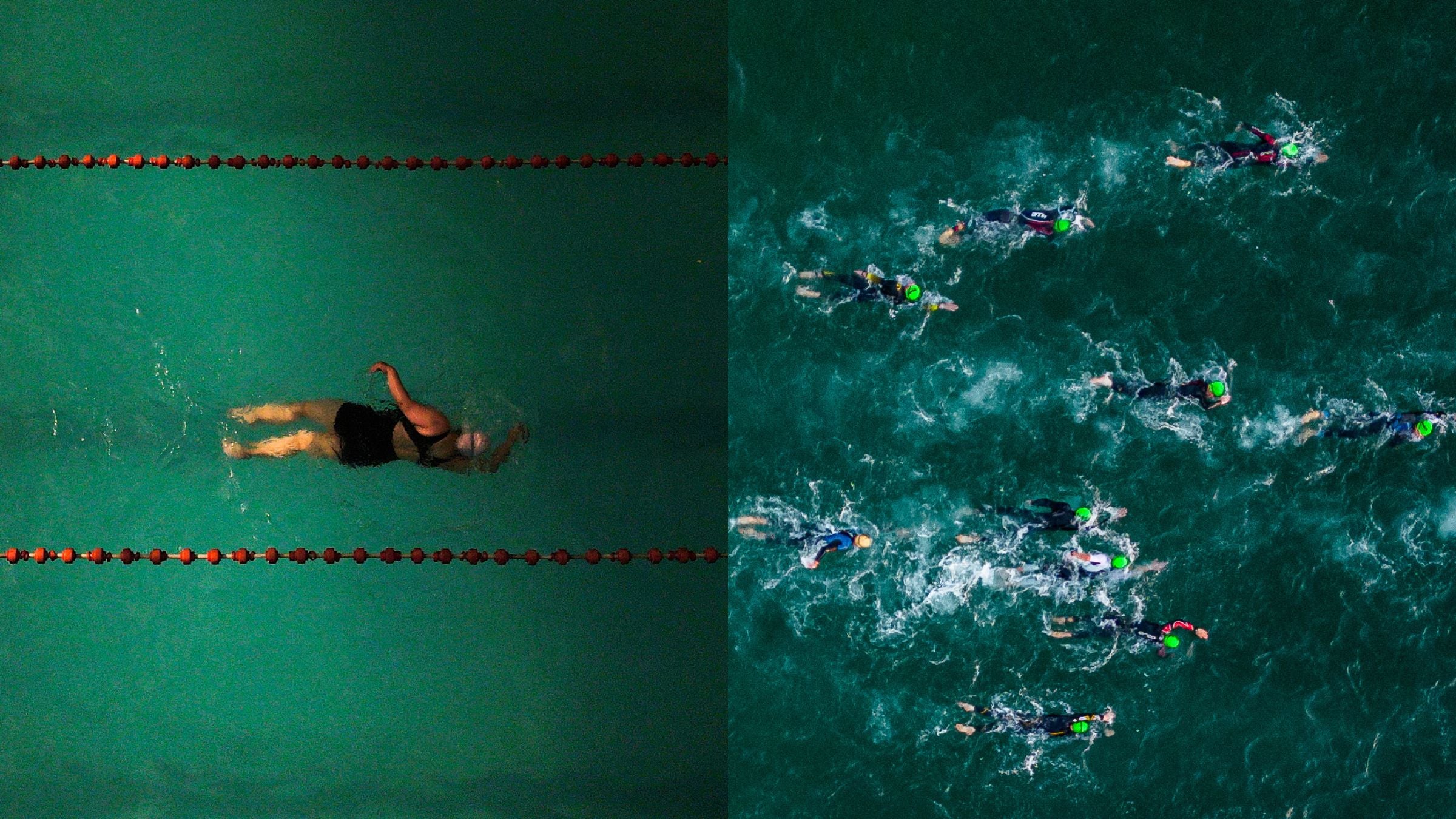Open-Water Swim Skills: How to Perfect Them in the Pool

It's possible (and important!) to practice open-water skills in the pool before your triathlon. (Photo: Luis Gandarillas/Octavio Passos/Getty Images)
As triathletes, we almost always race in open water, but so much of our training revolves around pool swimming. The two are not the same, however – those who solely train in the pool often find they’re woefully unprepared for what they encounter in open water on race day. But that doesn’t mean all is lost! In fact, even though access to open water isn’t easy for everyone, it’s still possible to practice some open-water swim skills — like sighting, drafting, and pacing—in the pool. Try adding some of these sets to your swim workout to practice certain open-water skills in the pool.
Practicing Open-Water Swim Skills: Sighting Set
In the pool, you’re simply following the line painted at the bottom. But in open water, there is no line – and unless you’ve been practicing sighting, you might find yourself going off-course during your open-water swim at a race. Practicing sighting will help you stay on course, which will mean a faster, more efficient triathlon swim leg.
RELATED: How to Sight When Swimming in Open Water
How to practice sighting in the pool:
Place a water bottle or bright cone at the end of the lane. Complete a regular swim workout in its entirety, but add three “sights” per lap when swimming toward the cone. During the course of an Ironman swim, most athletes will sight more than 300 times, so practicing in training is important. Improve your efficiency by only lifting your eyes out of the water—not your whole head—and taking a quick glance forward.
Open-Water Swim Skills: Drafting Set
We’ve said it before, and we’ll say it again, if you’re not drafting on the swim, you’re missing out on free speed. Just like on the bike, drafting – or entering the slipstream behind another athlete – lets you swim faster with less energy. But unlike most triathlon races, where drafting on the bike is not allowed, this practice is perfectly legal during the swim leg. But race day shouldn’t be the first time you put this into play – drafting is as much an art as it is a science, and you’ll learn this firsthand the first few times you try it.
RELATED: Drafting Correctly Can Make a Big Difference in Your Swim
How to practice drafting in the pool:
Set up a training date with a few swimmers of similar speed. After warming up, regroup for a main set of 400s. Circle swim in one lane and start directly on the feet of the athlete in front of you. After each 100, the lead swimmer pauses on the wall to let the rest of the group pass and then rejoins the back of the group (think of how a cycling pack rotates). Repeat the 400s on an interval that gives 30 seconds rest.
Also try reversing the rotation of the group to make the set more challenging. After every 100, the last swimmer sprints to the front of the group to take the lead.
Open-Water Swim Skills: Preparation Set
Plan for the expected—and the unexpected—to happen in open water. An uneventful swim rarely happens in triathlon, so it’s important to be prepared for anything and everything: recovering after going out too hard, leaky goggles, or choppy waves that make it difficult to breathe on your favored side or at your usual breath rate. (Seriously, folks: Learn how to bilateral breathe when swimming!)
RELATED: A Complete Guide to Triathlon Swimming
Triathlon Race Day Swim Simulation:
Check out this main set designed to mimic some of the issues that can occur on race day:
10 x 200 with :20 rest, as:
1, 2 – 50 sprint, 50 easy, repeat
3, 4 – 25 back, 25 breast, 150 free
5 – 100 free, climb out and dive back in, 100 free
6, 7 – fill goggles with water, fix them while swimming
8, 9 – 50 breathing every 5 strokes, 50 normal breathing, repeat
10 – 25 sprint kick, 75 swim, repeat
What to practice in open water
You made it to a body of water other than a pool! Now practice these race-specific scenarios:
Beach starts: Run into the water, dolphin dive, and swim 10–20 strokes fast. Swim easy back to the beach and repeat.
Deep-water starts: Tread water for 30 seconds and then swim 10–20 strokes fast. Swim easy for a few strokes to regroup and repeat.
Drafting: Similar to the pool workout, pair up with swimmers of a similar speed, and swim in a line between two points in the open water. Switch the leader every 1–2 minutes.
Swim straight: Swim to a buoy 50–100m away without sighting, and note which way you went off course. Adjust your track each time until you can swim to the buoy without looking.
RELATED: Triathlete’s Guide To Going From Pool To Open Water